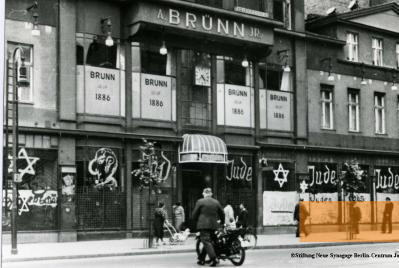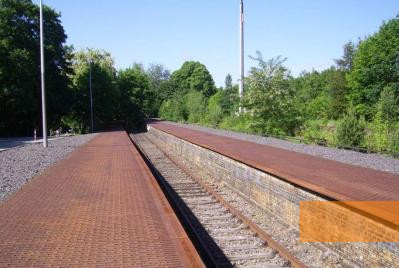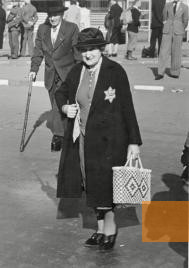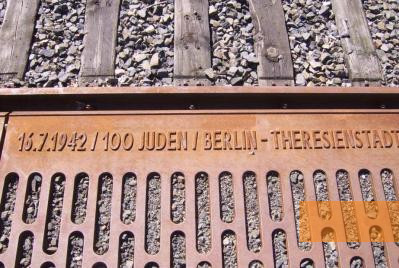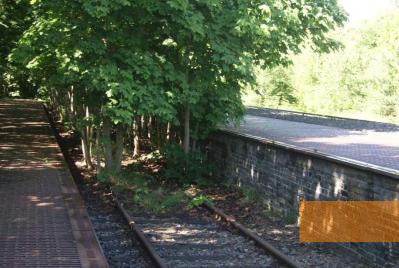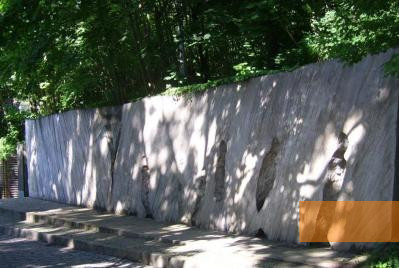The Grunewald S-Bahn station is located on the western outskirts of Berlin. Between autumn 1941 and most probably spring 1942, deportation trains carrying Berlin Jews to ghettos and extermination camps in the east departed from this train station. The creation of the memorial was initiated by the Deutsche Bahn, the German national railway company, to commemorate the deportations undertaken by its predecessor, the Deutsche Reichsbahn.
On October 18, 1941, the Reich Main Security Office began deporting Jews from Berlin, in cooperation with the Reich Ministry of Transport. That day, a special train of the Deutsche Reichsbahn left the Grunewald train station carrying about 1,000 Berlin Jews. This first transport was headed for the Łódź Ghetto. The police and SS had assembled the people for this transport in a collection camp for Jews, which was located in the synagogue in Levetzowstraße in Berlin's Moabit district. They then chased most of the men, women and children to Grunewald by foot. Until March 1945, about 180 further transports from Berlin to the ghettos followed; from August 1942, transports were also directly headed for extermination camps. From 1942 on, deportation trains also left from the Anhalter train station and the freight terminal Moabit. The deportations were planned by the Reich Main Security Office and conducted by local security police. The National Socialist authorities relied on cooperation with the Reichsbahn in order to carry out the deportations. At first, the special trains consisted of passenger cars, yet from 1942 on, the Reichsbahn increasingly began using cattle cars for the deportations. The »conveyance« of the Jews was billed to the Jewish community: 4 pfennigs were charged per kilometre for adults and 2 pfennigs for children above the age of four.
Over 50,000 Jews perished following their deportation from Berlin. Many of the transports were destined for the ghettos in Theresienstadt, Minsk, Riga, Kaunas and Łódź. From July 1942 on, several transports of Berlin Jews went directly to Auschwitz-Birkenau and other death camps. About 500 Jews from cities and communities in the vicinity of the capital were also deported from Berlin.
Already at the end of the 1980s, the state of Berlin initiated a tender competition for a concept of a monument to the deportations which left from the Grunewald train station. The winning design was by Karol Broniatowski, a Polish artist. The monument – an 18-metre concrete block with embedded silhouettes of deportees – was unveiled at the historic site in 1991. In the course of debates on the role of the Deutsche Reichsbahn during the National Socialist period, the board of the Deutsche Bahn decided to erect a central memorial. The »Hirsch, Lorch und Wandel« team of architects won the competition for the memorial's design. The Gleis 17 Memorial which they designed has commemorated the deportations conducted by the Deutsche Reichsbahn between 1941 and 1945 since 1998. 186 cast steel objects, referring to the number of transports that left Berlin, are embedded in the gravel along track 17. Inscribed on them are the dates of the transports, the number of deportees as well as the train's route. In addition, about 160 metres of the loading bay have been reconstructed.
- Name
- Mahnmal Gleis 17 – Berlin Grunewald
- Address
-
Am Bahnhof Grunewald 1
14193 Berlin - Web
- https://www.deutschebahn.com/de/konzern/geschichte/mahnmal-1187914
- oeffentlichkeitsarbeit@deutschebahn.com
- Open
- The memorial is accessible at all times


